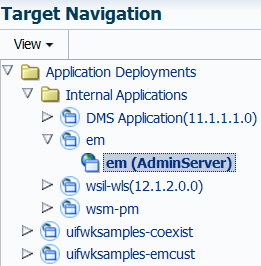2 Getting Started with Managing Oracle ADF
This chapter describes how to use Oracle Enterprise Fusion Middleware Control to perform ADF application configuration, monitor performance, and setting up logs. It also describes how to use the ADF-specific WebLogic Scripting Tool (WLST).
This chapter contains the following sections:
-
Section 2.2, "Getting Started Using Fusion Middleware Control to Manage ADF"
-
Section 2.4, "Using the Oracle WebLogic Administration Console"
2.1 Overview of ADF Administration Tools
You can use Enterprise Manager Fusion Middleware Control, WLST commands, or Oracle WebLogic Administration Console to manage and configure ADF applications.
Oracle offers the following primary tools for managing your Oracle Fusion Middleware installations:
-
Oracle Enterprise Manager Fusion Middleware Control. See Section 2.2.
-
The Oracle Fusion Middleware command-line tools. See Section 2.3.
-
Oracle WebLogic Server Administration Console. See Section 2.4.
-
The Fusion Middleware Control MBean Browser. See Section 2.5.
2.2 Getting Started Using Fusion Middleware Control to Manage ADF
For information about navigating within Fusion Middleware Control and a description of its elements and main menus, see "Navigating Within Fusion Middleware Control" in the Administering Oracle Fusion Middleware.
Fusion Middleware Control is a Web browser-based, graphical user interface that you can use to monitor and administer Oracle Fusion Middleware.
To navigate to Oracle Application Development Framework pages in Fusion Middleware Control:
-
Enter the Fusion Middleware Control URL, which includes the name of the host and the port number assigned to Fusion Middleware Control during the installation. The following shows the format of the URL
http://hostname.domain:port/em
The port number is the number of the Administration Server of Oracle WebLogic Server By default, the port number is 7001.
-
Enter the Oracle Fusion Middleware administrator user name and password and click Login.
-
From the navigation pane, expand the farm and then Application Deployments, and select the ADF application.

Description of the illustration ''gs_select_app.png''
The ADF home page displays.
-
Select the Application Deployment menu and then the ADF menu.

Description of the illustration ''gs_adf_menu.png''
The ADF menu displays the following options.
Menu Option Description ADF Performance Displays the Application Module Pool performance tab and the ADF Taskflows tab. For more information, see Section 3.2.4, "Viewing Application Module Pool Performance," and Section 3.2.5, "Viewing ADF Task Flow Performance."
Configure ADF Business Components Configure the ADF Business Components. You can select configuration tabs for: -
Pooling and Scalability - Application Pool Properties
-
Pooling and Scalability - Connection Pool Properties
-
Core
-
Database Properties
-
Security Properties
For more information, see Section 3.3.1, "Modifying ADF Business Components Parameters."
Configure ADF Connections Allows you create and edit connections that are available to ADF applications. For more information, see Section 3.3.2, "Modifying Connection Configurations."
Configure ADF (adf-config) Allows you to configure ADF application properties using the System MBean Browser. For more information, see Section 3.4.1, "Modifying ADF Application Configurations Using MBeans."
ADF Log Configuration Allows you to configure the logging levels for ADF Loggers. For more information, see "Managing Log Files and Diagnostic Data" chapter in Administering Oracle Fusion Middleware.
Versions Allows you to find the version information of ADF runtime JAR files. For more information, see Section 3.2.2, "Finding Version Information of ADF Runtime JARs."
ADF Resource Center Provides links to ADF resources such as documentation, knowledge base, forums, demos, samples, and software downloads. -
2.3 Using the WebLogic Scripting Tool
You can also use Oracle WebLogic Scripting Tool (WLST) to create, manage, and monitor Oracle WebLogic Server domains. WLST is a command-line based on Jython. ADF provides a set of custom WLST commands that can use to perform functions specifically for ADF applications.
For more information about using WLST, see "Using the WebLogic Scripting Tool" in Understanding the WebLogic Scripting Tool and "Getting Started Using the Oracle WebLogic Scripting Tool (WLST)" in Administering Oracle Fusion Middleware.
For reference information about the ADF WLST commands, see Chapter 7, "WLST Command Reference for ADF Applications."
To access the ADF-specific WLST commands:
-
Go to the Oracle Common home directory for your installation, for example
/home/Oracle/Middleware/oracle_common.For information about the Oracle Common home directory and installing Oracle Fusion Middleware, see Planning an Installation of Oracle Fusion Middleware.
-
Start Oracle WebLogic Server.
-
Start WLST using the
WLST.sh/cmdcommand located in theoracle_common/common/bindirectory. For example:-
/home/Oracle/Middleware/oracle_common/common/bin/wlst.sh(UNIX) -
C:\Oracle\Middleware\oracle_common\common\bin\wlst.cmd(Windows)
-
-
Connect to the running WebLogic Server instance using the
connect()command. For example, the following command connects WLST to the Admin Server at the URLmyAdminServer.example.com:7001using the username/password credentialsmy_username/my_password:connect("my_username","my_password","t3://myAdminServer.example.com:7001")
For reference information about the ADF WLST commands, see Chapter 7, "WLST Command Reference for ADF Applications."
2.4 Using the Oracle WebLogic Administration Console
You can use the Oracle WebLogic Administration Console to manage Oracle WebLogic Server domains. The console runs in a Web browser and has a graphical user interface.
For more information, see "Getting Started Using Oracle WebLogic Server Administration Console" in Administering Oracle Fusion Middleware.
2.5 Using the Fusion Middleware Control MBean Browsers
Fusion Middleware Control provides a set of MBean browsers that allow to you view the MBeans for an application or for an Oracle WebLogic Server. You can also use the MBean browser to perform monitoring and configuration tasks.
For more information, see "Getting Started Using the Fusion Middleware Control MBean Browsers" in Administering Oracle Fusion Middleware.